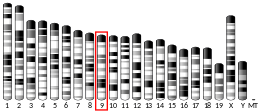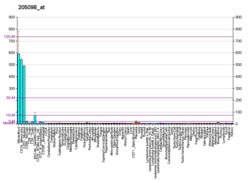CCR1
C-C chemokine receptor type 1 is a protein that in humans is encoded by the CCR1 gene.[5]
CCR1 has also recently been designated CD191 (cluster of differentiation 191).
Function
This gene encodes a member of the beta chemokine receptor family, which belongs to G protein-coupled receptors. The ligands of this receptor include CCL3 (or MIP-1 alpha), CCL5 (or RANTES), CCL7 (or MCP-3), and CCL23 (or MPIF-1). Chemokines and their receptors, which mediate signal transduction, are critical for the recruitment of effector immune cells to the site of inflammation. Knockout studies of the mouse homolog suggested the roles of this gene in host protection from inflammatory response, and susceptibility to virus and parasite. This gene and other chemokine receptor genes, including CCR2, CCRL2, CCR3, CCR5 and CXCR1, are found to form a gene cluster on chromosome 3p.[6]
Interactions
CCR1 has been shown to interact with CCL5.[7][8]
References
- GRCh38: Ensembl release 89: ENSG00000163823 - Ensembl, May 2017
- GRCm38: Ensembl release 89: ENSMUSG00000025804 - Ensembl, May 2017
- "Human PubMed Reference:". National Center for Biotechnology Information, U.S. National Library of Medicine.
- "Mouse PubMed Reference:". National Center for Biotechnology Information, U.S. National Library of Medicine.
- Neote K, DiGregorio D, Mak JY, Horuk R, Schall TJ (February 1993). "Molecular cloning, functional expression, and signaling characteristics of a C-C chemokine receptor". Cell. 72 (3): 415–25. doi:10.1016/0092-8674(93)90118-A. PMID 7679328.
- "Entrez Gene: CCR1 chemokine (C-C motif) receptor 1".
- Struyf S, Menten P, Lenaerts JP, Put W, D'Haese A, De Clercq E, Schols D, Proost P, Van Damme J (July 2001). "Diverging binding capacities of natural LD78beta isoforms of macrophage inflammatory protein-1alpha to the CC chemokine receptors 1, 3 and 5 affect their anti-HIV-1 activity and chemotactic potencies for neutrophils and eosinophils". European Journal of Immunology. 31 (7): 2170–8. doi:10.1002/1521-4141(200107)31:7<2170::AID-IMMU2170>3.0.CO;2-D. PMID 11449371.
- Proudfoot AE, Fritchley S, Borlat F, Shaw JP, Vilbois F, Zwahlen C, Trkola A, Marchant D, Clapham PR, Wells TN (April 2001). "The BBXB motif of RANTES is the principal site for heparin binding and controls receptor selectivity". The Journal of Biological Chemistry. 276 (14): 10620–6. doi:10.1074/jbc.M010867200. PMID 11116158.
Further reading
- Gerard C, Gerard NP (1994). "C5A anaphylatoxin and its seven transmembrane-segment receptor". Annual Review of Immunology. 12 (1): 775–808. doi:10.1146/annurev.iy.12.040194.004015. PMID 8011297.
- Ruibal-Ares BH, Belmonte L, Baré PC, Parodi CM, Massud I, de Bracco MM (January 2004). "HIV-1 infection and chemokine receptor modulation". Current HIV Research. 2 (1): 39–50. doi:10.2174/1570162043484997. PMID 15053339.
- Nomura H, Nielsen BW, Matsushima K (October 1993). "Molecular cloning of cDNAs encoding a LD78 receptor and putative leukocyte chemotactic peptide receptors". International Immunology. 5 (10): 1239–49. doi:10.1093/intimm/5.10.1239. PMID 7505609.
- Ben-Baruch A, Xu L, Young PR, Bengali K, Oppenheim JJ, Wang JM (September 1995). "Monocyte chemotactic protein-3 (MCP3) interacts with multiple leukocyte receptors. C-C CKR1, a receptor for macrophage inflammatory protein-1 alpha/Rantes, is also a functional receptor for MCP3". The Journal of Biological Chemistry. 270 (38): 22123–8. doi:10.1074/jbc.270.38.22123. PMID 7545673.
- Post TW, Bozic CR, Rothenberg ME, Luster AD, Gerard N, Gerard C (December 1995). "Molecular characterization of two murine eosinophil beta chemokine receptors". Journal of Immunology. 155 (11): 5299–305. PMID 7594543.
- Gao JL, Kuhns DB, Tiffany HL, McDermott D, Li X, Francke U, Murphy PM (May 1993). "Structure and functional expression of the human macrophage inflammatory protein 1 alpha/RANTES receptor". The Journal of Experimental Medicine. 177 (5): 1421–7. doi:10.1084/jem.177.5.1421. PMC 2191019. PMID 7683036.
- Combadiere C, Ahuja SK, Van Damme J, Tiffany HL, Gao JL, Murphy PM (December 1995). "Monocyte chemoattractant protein-3 is a functional ligand for CC chemokine receptors 1 and 2B". The Journal of Biological Chemistry. 270 (50): 29671–5. doi:10.1074/jbc.270.50.29671. PMID 8530354.
- Kuang Y, Wu Y, Jiang H, Wu D (February 1996). "Selective G protein coupling by C-C chemokine receptors". The Journal of Biological Chemistry. 271 (8): 3975–8. doi:10.1074/jbc.271.8.3975. PMID 8626727.
- Boring L, Gosling J, Monteclaro FS, Lusis AJ, Tsou CL, Charo IF (March 1996). "Molecular cloning and functional expression of murine JE (monocyte chemoattractant protein 1) and murine macrophage inflammatory protein 1alpha receptors: evidence for two closely linked C-C chemokine receptors on chromosome 9". The Journal of Biological Chemistry. 271 (13): 7551–8. doi:10.1074/jbc.271.13.7551. PMID 8631787.
- Gong X, Gong W, Kuhns DB, Ben-Baruch A, Howard OM, Wang JM (May 1997). "Monocyte chemotactic protein-2 (MCP-2) uses CCR1 and CCR2B as its functional receptors". The Journal of Biological Chemistry. 272 (18): 11682–5. doi:10.1074/jbc.272.18.11682. PMID 9115216.
- Daugherty BL, Springer MS (April 1997). "The beta-chemokine receptor genes CCR1 (CMKBR1), CCR2 (CMKBR2), and CCR3 (CMKBR3) cluster within 285 kb on human chromosome 3p21". Genomics. 41 (2): 294–5. doi:10.1006/geno.1997.4626. PMID 9143512.
- Pakianathan DR, Kuta EG, Artis DR, Skelton NJ, Hébert CA (August 1997). "Distinct but overlapping epitopes for the interaction of a CC-chemokine with CCR1, CCR3 and CCR5". Biochemistry. 36 (32): 9642–8. doi:10.1021/bi970593z. PMID 9289016.
- Coulin F, Power CA, Alouani S, Peitsch MC, Schroeder JM, Moshizuki M, Clark-Lewis I, Wells TN (September 1997). "Characterisation of macrophage inflammatory protein-5/human CC cytokine-2, a member of the macrophage-inflammatory-protein family of chemokines". European Journal of Biochemistry / FEBS. 248 (2): 507–15. doi:10.1111/j.1432-1033.1997.00507.x. PMID 9346309.
- Youn BS, Zhang SM, Broxmeyer HE, Cooper S, Antol K, Fraser M, Kwon BS (May 1998). "Characterization of CKbeta8 and CKbeta8-1: two alternatively spliced forms of human beta-chemokine, chemoattractants for neutrophils, monocytes, and lymphocytes, and potent agonists at CC chemokine receptor 1". Blood. 91 (9): 3118–26. PMID 9558365.
- Nardelli B, Tiffany HL, Bong GW, Yourey PA, Morahan DK, Li Y, Murphy PM, Alderson RF (January 1999). "Characterization of the signal transduction pathway activated in human monocytes and dendritic cells by MPIF-1, a specific ligand for CC chemokine receptor 1". Journal of Immunology. 162 (1): 435–44. PMID 9886417.
- Shaw KT, Greig NH (January 1999). "Chemokine receptor mRNA expression at the in vitro blood-brain barrier during HIV infection". NeuroReport. 10 (1): 53–6. doi:10.1097/00001756-199901180-00010. PMID 10094132.
- Zhang S, Youn BS, Gao JL, Murphy PM, Kwon BS (April 1999). "Differential effects of leukotactin-1 and macrophage inflammatory protein-1 alpha on neutrophils mediated by CCR1". Journal of Immunology. 162 (8): 4938–42. PMID 10202040.
- Lalani AS, Masters J, Zeng W, Barrett J, Pannu R, Everett H, Arendt CW, McFadden G (December 1999). "Use of chemokine receptors by poxviruses". Science. 286 (5446): 1968–71. doi:10.1126/science.286.5446.1968. PMID 10583963.
External links
- Human CCR1 genome location and CCR1 gene details page in the UCSC Genome Browser.
- "Chemokine Receptors: CCR1". IUPHAR Database of Receptors and Ion Channels. International Union of Basic and Clinical Pharmacology.
This article incorporates text from the United States National Library of Medicine, which is in the public domain.





